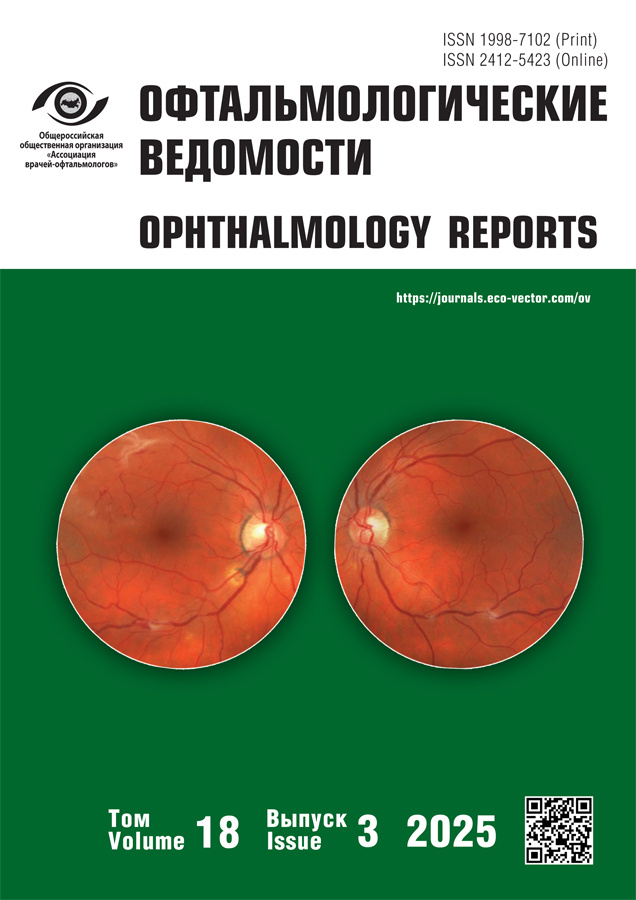Comparative assessment of hyperosmolar therapy after endonasal endoscopic dacryocystorhinostomy
- Authors: Beldovskaya N.Y.1, Karpov A.A.1, Morozova M.K.1
-
Affiliations:
- Academician I.P. Pavlov First St. Petersburg State Medical University
- Issue: Vol 18, No 3 (2025)
- Pages: 43-48
- Section: Original study articles
- Submitted: 14.07.2025
- Accepted: 13.08.2025
- Published: 30.09.2025
- URL: https://journals.eco-vector.com/ov/article/view/687520
- DOI: https://doi.org/10.17816/OV687520
- EDN: https://elibrary.ru/KSFGLL
- ID: 687520
Cite item
Abstract
BACKGROUND: Currently, endonasal endoscopic dacryocystorhinostomy is considered the most effective and safe surgical procedure for narrowing or obstruction of the lacrimal duct. There is now extensive clinical experience of this condition management, both diagnostic and postoperative. Nevertheless, relapses occurring in 10% of cases reduce the treatment effectiveness. They may be caused by granulomas at rhinostomy opening and intranasal synechiae. The outcome of endonasal endoscopic dacryocystorhinostomy largely depends on proper postoperative management. Today, hyperosmolar solutions are used postoperatively to improve outcomes of ocular surgery. However, there is few data on using these agents in nasolacrimal duct surgery.
AIM: The study aimed to evaluate the clinical effectiveness of hyperosmolar solutions in patients with postoperative edema of the conjunctiva and nasal mucosa after endonasal endoscopic dacryocystorhinostomy.
METHODS: The study was conducted at the Ophthalmology and Otorhinolaryngology Departments of Pavlov First Saint Petersburg State Medical University. Patients who underwent primary endonasal endoscopic dacryocystorhinostomy were enrolled. The control group received a combination medicinal product with antibacterial and anti-inflammatory effects, moisturizer, and topical nasal glucocorticosteroids for 1 month. The study group received 3% NaCl for irrigation of the conjunctival sac and a 21 g/L hypertonic saline intranasally in addition to the agents mentioned above. The effectiveness was assessed based on complaints of lacrimation and nasal breathing difficulties, biomicroscopy of the anterior segment, Norn test, endoscopy of the nasal cavity, and the results of lacrimal duct irrigation.
RESULTS: A total of 60 patients (62 eyes). Control group: 30 eyes, study group: 32 eyes were enrolled. In the study group, edema of the conjunctiva and nasal mucosa resolved by postoperative day 7. In the control group, severity of nasal cavity edema was 5% higher by day 7. By day 30, severity of nasal cavity edema was 1% and 5% in the study and control groups, respectively.
CONCLUSION: Postoperative therapy with topical hyperosmolar eye drops and nasal sprays after endonasal endoscopic dacryocystorhinostomy relieves edema of the nasal mucosa and lacrimal duct and prevents recurrent rhinostomy opening scarring.
Full Text
About the authors
Natalya Yu. Beldovskaya
Academician I.P. Pavlov First St. Petersburg State Medical University
Email: beldovskay@mail.ru
ORCID iD: 0000-0001-9864-504X
SPIN-code: 8331-1449
MD, Cand. Sci. (Medicine), Assistant Professor
Russian Federation, Saint PetersburgArtemiy A. Karpov
Academician I.P. Pavlov First St. Petersburg State Medical University
Email: artemiykarpov@mail.ru
ORCID iD: 0000-0001-8519-6054
SPIN-code: 3226-3334
MD
Russian Federation, Saint PetersburgMariya K. Morozova
Academician I.P. Pavlov First St. Petersburg State Medical University
Author for correspondence.
Email: marusya.morozova@gmail.com
Russian Federation, Saint Petersburg
References
- Vinciguerra A, Nonis A, Giordano Resti A, et al. Best treatments available for distal acquired lacrimal obstruction: a systematic review and meta-analysis. Clin Otolaryngol. 2020;45(4):545–557. doi: 10.1111/coa.13551. EDN: YCFFRD
- Magomedov MM, Artemyev ME, Amirov AM, Medzhidova DM. Causes of recurrent lacrimation after endonasal endoscopic dacryocystorhinostomy. Russian rhinology. 2007;(2):131. EDN: IAVJWJ (In Russ.)
- Becker BB. Cultures of proximal and distal segments of silicone tubes after dacryocystorhinostomy. Ophthalmic Plast Reconstr Surg. 2019;35(1):42–44. doi: 10.1097/IOP.0000000000001149
- Murphy J, Ali MJ, Psaltis AJ. Biofilm quantification on nasolacrimal silastic stents after dacryocystorhinostomy. Ophthalmic Plast Reconstr Surg. 2015;31(5):396–400. doi: 10.1097/IOP.0000000000000361
- Sarode D, Bari DA, Cain AC, et al. The benefit of silicone stents in primary endonasal dacryocystorhinostomy: a systematic review and meta-analysis. Clin Otolaryngol. 2017;42(2):307–314. doi: 10.1111/coa.12751
- Brzheskiy VV, Astakhov YuS, Kuznetsova NYu. Diseases of the lacrimal apparatus: a manual for practicing physicians. 2nd ed. Saint Petersburg: N-L; 2009. (In Russ.)
- Astakhov YuS, Nikolaenko VP, editors. Guide for doctors. Ophthalmology. Pharmacotherapy without errors. 2nd ed. Moscow: E-noto; 2021. 800 p.
- Mitrofanov PP. Prevention and treatment of infected wounds with 10 % solution of table salt. Kazan Medical Journal. 1935;31(1):72–74. (In Russ.)
- Khripun KV, Nizametdinov YS, Varganova TS. Therapeutic efficacy of 3 % NaCl hypertonic solution in postoperative corneal edema. Ophthalmology Reports. 2018;11(2):81–86. doi: 10.17816/OV11281-86 EDN: XQCJZB
Supplementary files









